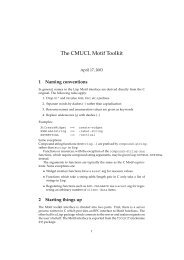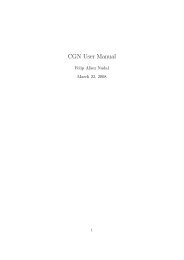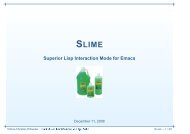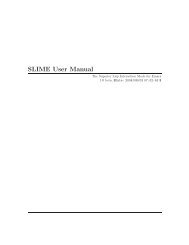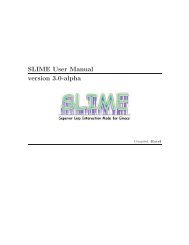Langutils: A Natural Language Toolkit for Common Lisp - Liu, Hugo
Langutils: A Natural Language Toolkit for Common Lisp - Liu, Hugo
Langutils: A Natural Language Toolkit for Common Lisp - Liu, Hugo
Create successful ePaper yourself
Turn your PDF publications into a flip-book with our unique Google optimized e-Paper software.
thinking first about algorithm and data structure choices<br />
and the impact of those choices on cache and CPU<br />
behavior. After those decisions are settled, we can focus in<br />
on optimizing <strong>for</strong> local code generation.<br />
In LISP, we aren’t <strong>for</strong>ced by default to always consider and<br />
make low-level per<strong>for</strong>mance choices, as is typical in C++.<br />
Because of this, additional knowledge is required to move<br />
from writing programs quickly to writing efficient<br />
programs. In one sense, optimizing LISP programs is<br />
harder than in more primitive languages because the<br />
surface syntax does not immediately in<strong>for</strong>m us as to the<br />
storage and computation costs at the machine level.<br />
Optimization of LISP programs requires new syntactic<br />
constructs such as inline type and optimization<br />
declarations, as well as consideration of the uses of first<br />
order procedures, consing and numbers. Properly cared <strong>for</strong>,<br />
however, LISP programs can per<strong>for</strong>m as well as any<br />
popular “high efficiency” language and above all, you only<br />
have to expend this ef<strong>for</strong>t in the higher level design and in a<br />
few low level building blocks – the rest of the program<br />
benefits from LISP rapid development model. In the toolkit<br />
we highlight on three primary classes of optimization:<br />
cache-sensitive data representations, algorithms that<br />
optimize <strong>for</strong> locality, and enabling efficient compilation.<br />
An immediate implementation choice facing a natural<br />
language library is choosing how to represent the input<br />
strings. You can maintain the original text and add<br />
annotations as part of the strings (e.g. tagging ‘run’ yields<br />
‘run/VBD’) or choose a less directly readable but more<br />
efficient machine representation. In MontyLingua the<br />
decision was made to leverage Python’s built-in regular<br />
expression library and per<strong>for</strong>m all processing directly in the<br />
text. This made it easy to describe regular expressions over<br />
text such that the code clearly reflected the intended<br />
semantics.<br />
In the case of <strong>Langutils</strong>, throughput was our top priority.<br />
We chose to map each unique natural language component<br />
to a unique integer token that serves as an index to various<br />
table-based resources such as the lexicon, stopword lists,<br />
and spelling corrections. This conversion takes place after<br />
tokenization and the lexical rule application during tagging,<br />
at which point all the original string content is converted<br />
into arrays of token integers. We use a CLOS class, the<br />
vector-document to maintain additional in<strong>for</strong>mation about<br />
the source text, such as origin and the list of POS tags<br />
generated by the tagger.<br />
4. TOKENIZATION<br />
In this section token is a generic term referring to<br />
contiguous sets of non-whitespace characters. Tokenization<br />
converts an input token stream to an output token stream<br />
separating punctuation from input tokens. As described in<br />
section 2, we only want to separate punctuation if it plays a<br />
direct syntactic role. Many punctuation characters are part<br />
of specific tokens, as in numbers (2.00), times (2:00) and<br />
dates (12/24/05).<br />
We observed in Section 2.1 that the process of identifying<br />
where to place new whitespace characters requires a<br />
contextual window of characters around the present<br />
position to be considered. This window is not of fixed size,<br />
prohibiting the use of a lookup table. In general we need to<br />
have available the in<strong>for</strong>mation <strong>for</strong> all the ways in which<br />
punctuation-containing tokens might get parsed so that we<br />
can separate sentence syntax markers from token syntax<br />
markers.<br />
The simplest approach to efficiently solving this problem is<br />
to build a simple automaton that directly recognizes all the<br />
valid cases of tokens within (i.e. floating point number vs.<br />
abbreviation vs. end of sentence). Rather than build the<br />
infrastructure <strong>for</strong> efficient parsing from scratch, we chose<br />
to follow the techniques described in Henry Baker’s classic<br />
paper on META [1] that builds on a parsing technique<br />
described in [12].<br />
4.1 META<br />
META is a macro package and design methodology in<br />
which it is easy to describe near optimal parsing <strong>for</strong> a wide<br />
variety of languages. Moreover, like the Attributed<br />
Grammars that most undergraduate CS majors learn,<br />
META expressions can per<strong>for</strong>m computations while they<br />
are matching sub-expressions in the input.<br />
META expressions are based on a reader syntax and macro<br />
package <strong>for</strong> building conjunctions and disjunctions, type<br />
assertions and in-line procedure calls (acting as terminal or<br />
non-terminal productions). The with-string-meta macro<br />
uses variable capture in the top level macro to provide<br />
standard labels (index, string) describing the state of the<br />
parser so we can easily create local state markers in<br />
procedures to implement arbitrary look-ahead and<br />
backtracking <strong>for</strong> sub-expressions. A meta-match macrolet<br />
is defined by the top-level macro and matches META<br />
expressions against the current state, returning t or nil based<br />
on whether that expression matched or not. By putting<br />
various meta-match calls into labels statements and<br />
recording the starting value of index, we can easily have<br />
our expressions broken up and reused. This improves<br />
readability but also enables the parsing of a large class of<br />
context-free grammars.<br />
META provides reader syntax <strong>for</strong> generating compact<br />
meta-match expressions. In these expressions, [e1 e2 …]<br />
means AND, {e1 e2 …} means OR, !(expr) means evaluate<br />
the expression ‘expr’ and @(test var) means to do a type






